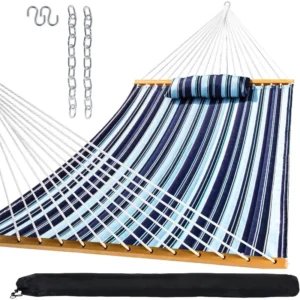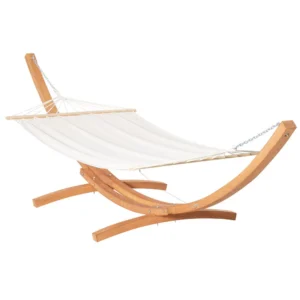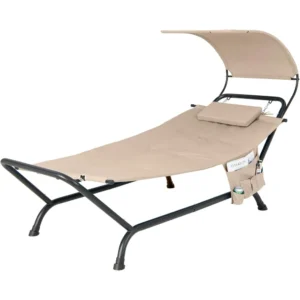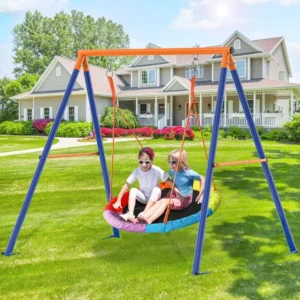Understanding A-Frame Support Systems for Hammocks
A-frame hammock stands are freestanding structures designed to support hammocks without requiring trees, posts, or wall attachments. These versatile supports feature two angled legs on each side that meet at the top to create an “A” shape, providing stable suspension points for your hammock.
The structural integrity of these stands isn’t just about preventing catastrophic failure—it directly impacts your relaxation experience. When a stand is properly engineered for strength, you can enjoy peaceful swinging without worrying about stability issues or unexpected movements that interrupt your comfort.
Common concerns among hammock enthusiasts include:
– Whether the stand can safely support their body weight
– How the stand will handle dynamic movements like swinging or getting in and out
– Long-term durability, especially for outdoor use
– Stability on different surfaces
The engineering principles behind A-frame stands draw from centuries-old structural design concepts. By understanding the physics of load distribution, material properties, and geometric principles, manufacturers can create stands that safely support weights typically ranging from 250-500 pounds (113-227 kg).
In this article, we’ll explore everything from the fundamental physics of A-frame supports to practical considerations for selecting, building, and maintaining a stand that provides both safety and optimal relaxation. Proper indoor-outdoor hammock placement plays a crucial role in maximizing both safety and enjoyment, regardless of whether you’re using trees or stands for support.
Ready for some real-world examples? Our collection of premium A-frame stand hammock sets demonstrates these engineering principles in action with designs focused on both aesthetics and structural integrity.
The Engineering Behind A-Frame Hammock Support
Understanding the structural mechanics of A-frame hammock stands reveals why certain designs succeed while others fail. The engineering principles at work involve sophisticated concepts made simple through thoughtful design.
Load Distribution Fundamentals
A-frame stands must handle two types of forces:
- Static loads: The constant weight of your body at rest
- Dynamic loads: Forces created when entering, exiting, or swinging in the hammock
These dynamic loads can multiply the effective force on the stand by 1.5-3 times your actual weight, which explains why proper engineering requires significant safety margins.
Geometric Factors for Optimal Strength
The geometry of an A-frame stand dramatically impacts its stability and strength:
- Leg angles: The optimal leg angle ranges between 30-35 degrees from vertical. Too steep and the stand becomes unstable; too shallow and the legs experience excessive outward force.
- Base width: The wider the base footprint, the more stable the structure, with most quality stands featuring bases at least 4-5 feet (1.2-1.5 m) wide.
- Height-to-width ratio: A proper balance prevents tipping, with most designs maintaining a ratio where the height doesn’t exceed 1.2 times the width.
Forces in Action
When you lie in a hammock, the stand experiences several forces simultaneously:
- Tension pulls outward on the support points
- Compression pushes down through the legs
- Shear forces stress the joints where components meet
The center of gravity plays a crucial role in stability—quality designs ensure this point falls well within the base footprint, even when the user shifts position. This explains why durable hammock stand relaxation depends on proper engineering, not just sturdy materials.
Understanding these principles helps explain why proper hammock installation requirements emphasize specific angles and support configurations—these aren’t arbitrary rules but essential engineering considerations.
Material Selection: Impact on Strength and Durability
The materials used in A-frame hammock stands significantly influence their weight capacity, longevity, and overall performance. Each option presents distinct advantages and considerations worth understanding before making your choice.
Wood Options
Pressure-Treated Pine
– Strengths: Affordability, readily available, good resistance to rot and insects
– Considerations: Contains chemicals that may leach over time; moderately heavy; requires maintenance
Cedar
– Strengths: Naturally resistant to decay and insects; beautiful reddish color; pleasant aroma
– Considerations: Softer than many hardwoods; premium price point; may require reinforcement for heavier loads
Hardwoods (Oak, Maple, Teak)
– Strengths: Exceptional strength properties; beautiful grain patterns; potential weight capacities up to 450 pounds (204 kg)
– Considerations: Significantly heavier; higher cost; may require specialized tools to work with
Metal Options
Steel
– Strengths: Superior strength-to-size ratio; affordable; widely available in various profiles
– Considerations: Heavy; susceptible to rust without proper coating; requires welding for best joints
Aluminum
– Strengths: Lightweight; naturally corrosion-resistant; easy to transport
– Considerations: Lower weight capacity than steel; higher cost; requires larger diameter tubing (typically 1.5-2 inches/38-51 mm) to achieve adequate strength
Material Properties Comparison
| Material | Strength-to-Weight | Weather Resistance | Maintenance Needs | Typical Max Capacity |
|---|---|---|---|---|
| Pressure-Treated Pine | Moderate | Good | Moderate | 300-350 lbs (136-159 kg) |
| Cedar | Moderate | Excellent | Low | 275-325 lbs (125-147 kg) |
| Hardwoods | High | Varies by type | Moderate | 400-450 lbs (181-204 kg) |
| Steel | Very High | Poor without coating | Moderate | 400-600 lbs (181-272 kg) |
| Aluminum | Moderate | Excellent | Low | 250-400 lbs (113-181 kg) |
Each material requires specific maintenance considerations. Wood needs periodic sealing or staining, while metals may require rust prevention treatment or replacement of hardware. The strongest materials for hammock stands combine inherent material properties with proper engineering to create reliable support systems.
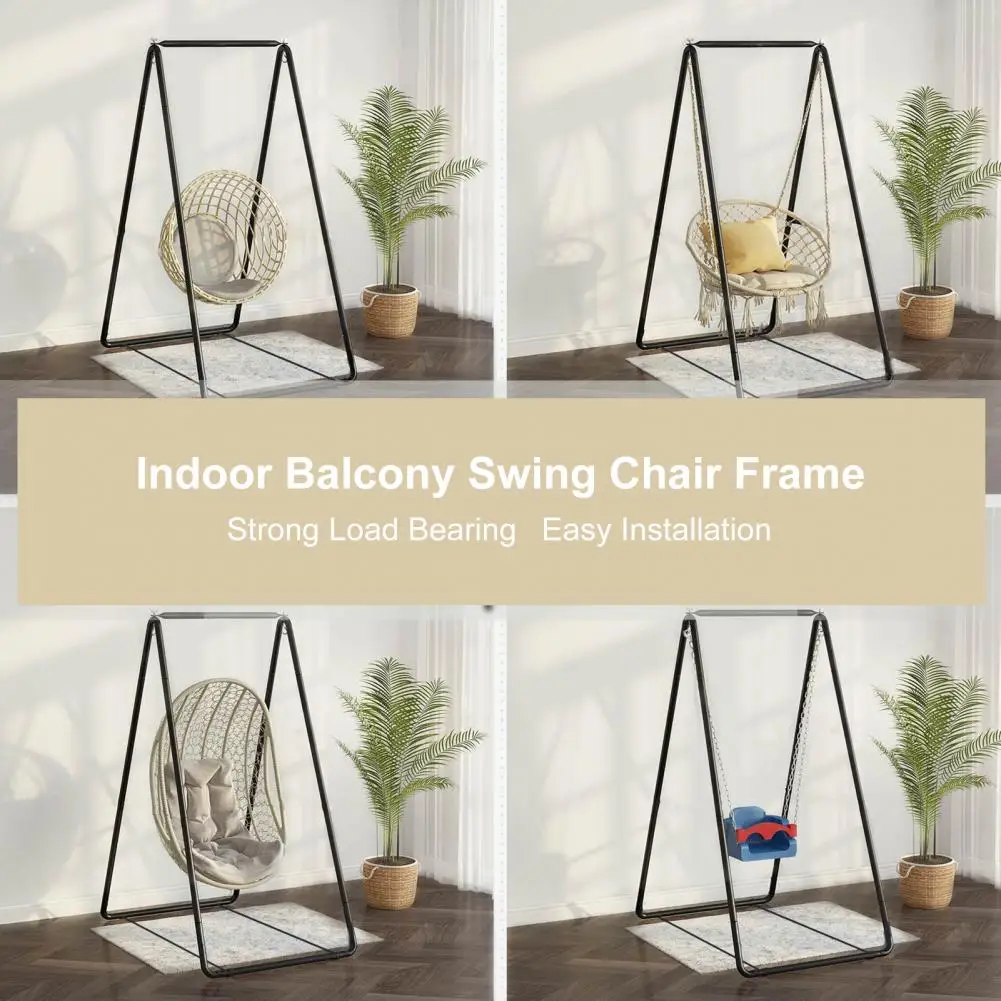
For those seeking maximum durability, our collection of heavy duty hammock sets features stands constructed with premium materials specifically selected for their strength and longevity.
Critical Design Elements for Maximum Stability
The structural integrity of an A-frame hammock stand depends not just on materials but on several crucial design elements that work together to create a safe, stable support system.
The Apex Connection
The point where the two legs meet at the top (the apex) represents one of the most critical stress points in the entire structure:
- Fastening Methods: High-quality stands employ robust connection systems such as:
- Through-bolts with lock nuts rather than standard wood screws
- Heavy-duty steel brackets that distribute force across a wider area
In metal stands, fully welded joints provide superior strength over bolted connections
Reinforcement Techniques: Quality stands incorporate additional structural elements:
- Triangular gusset plates at joints to prevent separation under tension
- Metal reinforcement plates on wooden designs
- Double-thickness material at connection points
Leg Design Considerations
The legs themselves must be engineered to withstand both compression and lateral forces:
- Construction Integrity: Solid one-piece legs offer superior strength compared to joined sections
- Angle Consistency: Both sides must maintain identical angles (typically 30-35°) to ensure balanced force distribution
- Material Thickness: Optimal dimensions vary by material:
- Wood: At least 1.5-2 inches (38-51 mm) thick for primary load-bearing components
- Steel: 16-gauge or heavier tubing
- Aluminum: Larger diameter tubing (1.5-2 inches/38-51 mm) with thicker walls
Base Stabilization Methods
A stable base prevents tipping and ensures consistent performance:
- Cross-Member Support: Horizontal supports connecting the legs near the ground prevent spreading
- Spreader Bars: Maintain proper distance between suspension points
- Footprint Optimization: Wider bases increase stability, with quality designs featuring at least 4-5 feet (1.2-1.5 m) of width
Hardware Selection
The connecting components often determine whether a stand succeeds or fails:
- Load Rating: All hardware should exceed the stand’s advertised capacity
- Material Quality: Stainless steel or hot-dipped galvanized components resist corrosion
- Proper Sizing: Undersized hardware creates weak points—quality designs use minimum 3/8-inch (10 mm) bolts with lock washers
For comprehensive guidance on maximizing stability in different settings, the ultimate guide to heavy duty hammock stands provides additional insights on reinforcement techniques and design optimization.
Building a DIY A-Frame Hammock Stand: Strength Considerations
Creating your own A-frame hammock stand can be a rewarding project that delivers a custom solution perfectly suited to your needs—provided you follow sound engineering principles throughout the process.
Pre-Construction Planning
Before cutting your first board or pipe, thorough planning establishes the foundation for a strong, stable stand:
- Skills Assessment: Be honest about your woodworking or metalworking abilities
- Tool Requirements: Ensure you have access to tools that can make precise cuts and create strong joints
- Material Selection: Choose materials based on:
- Weight capacity needs
- Indoor vs. outdoor use
- Visual preferences
Long-term durability requirements
Dimensional Planning: Most DIY wood stands require:
- Two 15-foot (4.6 m) 2×6 lumber pieces for legs
- Support cross-beams sized appropriately for your specific design
- Hardware rated for at least 1.5× your intended weight capacity
Construction Fundamentals
Follow these principles for optimal structural integrity:
- Precision Matters: Measure twice, cut once to ensure symmetrical components
- Joint Integrity: For wooden stands, half-lap joints provide significantly better strength than butt joints with simple screws
- Symmetry Focus: Uneven legs or angles create dangerous instability and uneven stress distribution
- Reinforcement Points: Add gussets or metal brackets at critical stress points
Testing Protocol
Before trusting your full weight to a DIY stand:
- Place the stand on level ground and check for wobbling or unevenness
- Apply weight gradually, starting with 50 pounds (23 kg)
- Increase weight incrementally while checking for any creaking, flexing, or movement
- Test dynamic forces by gently swinging with gradually increasing momentum
Many DIY enthusiasts find inspiration in portable hammocks stands, which showcase clever engineering solutions that balance strength with transportability. Understanding proper anchoring depths for wooden posts provides additional guidance for ground-contact components in DIY projects.
Evaluating Commercial A-Frame Hammock Stands
When shopping for pre-manufactured A-frame hammock stands, knowing how to evaluate their structural integrity ensures you invest in a product that delivers both safety and value.
Interpreting Manufacturer Specifications
Look beyond marketing claims to find these critical indicators:
- Weight Capacity Verification:
- Static weight rating (how much weight at rest)
- Dynamic weight capacity (accounting for movement)
Safety margin (quality stands have at least a 1.5× safety factor)
Material Quality Indicators:
- Specific wood or metal types (not just “hardwood” or “steel”)
- Thickness/gauge specifications for metal components
Treatment/finishing methods for outdoor durability
Construction Features:
- Joint types and reinforcement methods
- Hardware specifications (size, material, quality)
- Base stabilization systems
Quality Assessment Beyond Specifications
Physical examination reveals much about stand quality:
- Hardware Quality: Look for stands with at least 1/4-inch (6 mm) thick connecting plates at stress points
- Joint Construction: Welded joints should show consistent, smooth welds; wooden joints should feature reinforcements
- Stability Features: Cross-members, appropriate base width, and anti-tipping design elements
Value Assessment
Determine true value by considering:
- Price-to-Quality Ratio: Higher price should correlate with better materials and engineering
- Warranty Coverage: Longer warranties typically indicate manufacturer confidence
- Expected Lifespan: Quality stands should last 5-10+ years with proper care
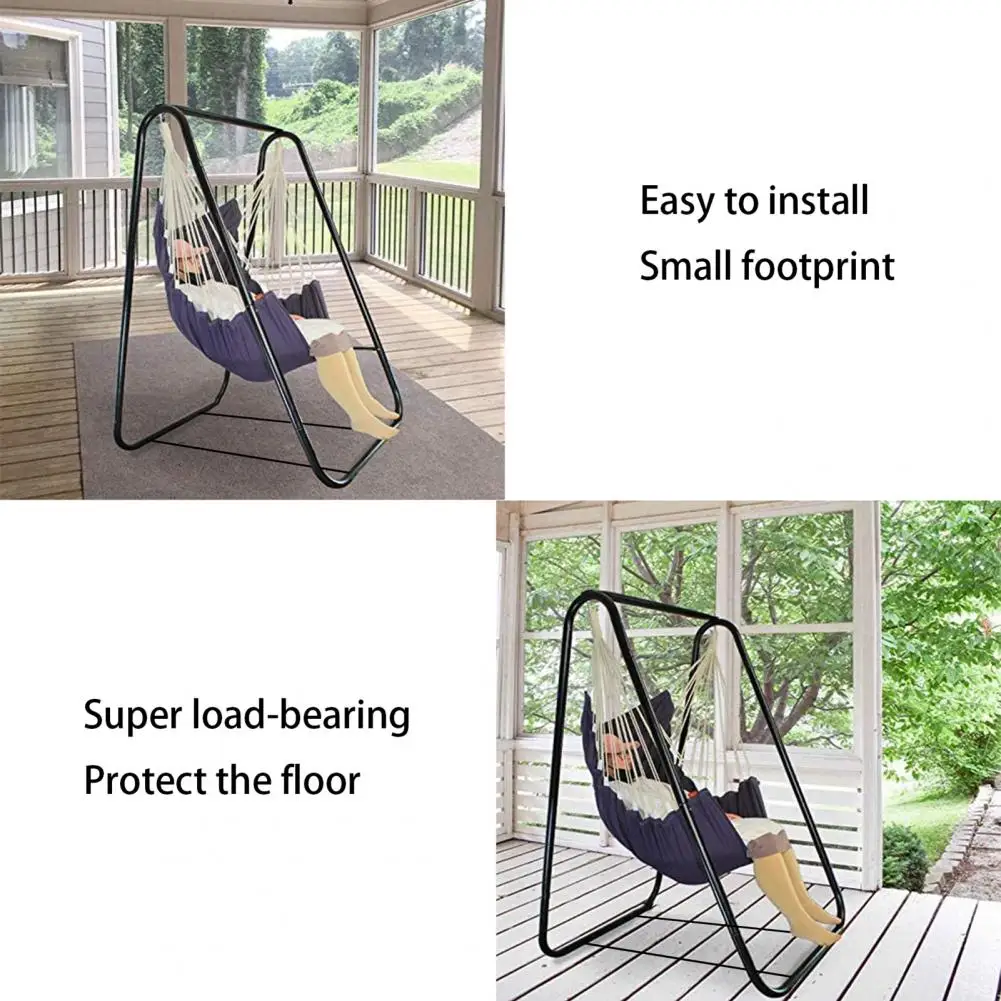
When considering indoor hammock safety, pay special attention to stands designed specifically for indoor use, which may have different stability features than outdoor models.
Browse our collection of premium hammocks with stands to see examples of commercial options that prioritize structural integrity alongside aesthetic design.
A-Frame Stand Hammock Sets, Swinging Hammock Chair Sets
$154.62 Select options This product has multiple variants. The options may be chosen on the product pageClassic Wooden Stand Hammock Sets, Heavy Duty Hammock Sets
$1,061.68 Select options This product has multiple variants. The options may be chosen on the product pageHammock Sets with Canopy, Heavy Duty Hammock Sets
$286.31 Select options This product has multiple variants. The options may be chosen on the product pageDouble / Two Person Hammock Sets, Rope Hammock Sets
Double Traditional Cotton Rope Hammock with Extension Chains – 450 lbs Capacity for Backyard & Patio$292.98 Select options This product has multiple variants. The options may be chosen on the product pageFolding Hammock Sets, Quick Setup Hammock Sets
Price range: $305.52 through $583.27 Select options This product has multiple variants. The options may be chosen on the product page
Essential Safety Practices: Preventing A-Frame Failures
Following proper safety protocols significantly reduces the risk of stand failure and creates a secure relaxation environment.
1. Respect Weight Limitations
- Never exceed the manufacturer’s stated weight capacity
- Remember that dynamic movements can double or triple the effective force on the stand
- For DIY stands, maintain a safety margin of at least 1.5× your actual weight
- Consider combined weights when contemplating tandem use
2. Proper Hammock Installation
- Use hardware specifically designed for hammock suspension
- Ensure hanging points align with the stand’s engineered suspension locations
- Maintain proper hammock sag (30° angle from horizontal is optimal)
- Avoid excessive side-to-side tension that could tip the stand
3. Regular Inspection and Maintenance
- Check all connection points before each use
- Inspect wooden components for cracks, splits, or rot
- Examine metal parts for rust, bending, or fatigue
- Tighten all hardware connections every 3 months or after periods of heavy use
4. Safe Usage Practices
- Enter and exit the hammock slowly, at the center point
- Limit swinging motions, especially on stands not specifically designed for dynamic movement
- Place stands on flat, level surfaces
- Keep the stand’s base area clear of objects that could affect stability
5. Recognize Warning Signs
- Creaking sounds during weight shifts indicate stress points
- Visible flexing or bending of components suggests overloading
- Progressive loosening of joints suggests structural fatigue
- Unusual movement or wobbling indicates potential failure points
Comprehensive indoor-outdoor hammock safety guidelines provide additional recommendations for creating a secure hammock environment in any setting.
Weather Exposure and Long-Term Durability
Environmental factors significantly impact the lifespan of A-frame hammock stands, especially those left outdoors for extended periods.
Environmental Impact Analysis
Different elements affect stand materials in various ways:
- UV Radiation: Causes wood to gray and crack; degrades certain plastics and finishes
- Moisture: Promotes rot in untreated wood; accelerates corrosion in metals
- Temperature Fluctuations: Create expansion/contraction cycles that stress joints and connections
Protective Measures
Extend the lifespan of your stand with these protective strategies:
- Appropriate Finishes:
- Wood stands benefit from marine-grade varnish with UV inhibitors
- Metal stands should have powder coating or rust-resistant paint
Apply new finishes annually for maximum protection
Protective Covers:
- Weather-resistant covers extend stand life significantly
- Look for covers with UV protection and water resistance
Ensure covers allow airflow to prevent moisture buildup
Strategic Placement:
- Position permanent outdoor stands with partial shade protection
- Consider prevailing winds when orienting the stand
- Avoid low areas where water collects
Off-Season Storage
When not in regular use:
- Store portable stands indoors during harsh weather
- Clean thoroughly and apply protective finishes before storage
- Store wooden components off the ground
- Keep all hardware in sealed containers to prevent loss or corrosion
Understanding whether hammocks can be left outside helps inform decisions about stand placement and protection. For permanent installations, following principles for perfect hammock placement optimizes both enjoyment and longevity.
How to Test and Verify Your A-Frame’s Strength
Before entrusting your full weight to any hammock stand, a systematic testing approach ensures safety and confirms structural integrity.
Initial Setup Verification
- Ensure Level Placement: Use a bubble level to verify the stand sits evenly on the ground
- Check All Connections: Verify that all bolts, screws, and joints are properly tightened
- Confirm Symmetry: Measure angles and distances to ensure equal distribution of forces
Progressive Loading Technique
- Start Small: Begin with 50 pounds (23 kg) of weight (sandbags, weights, or filled containers)
- Incremental Increases: Add weight in 25-50 pound (11-23 kg) increments
Observation Period: After each weight addition, wait 10-15 minutes while checking for:
– Unusual sounds
– Visible flexing or bending
– Joint movement
– Stand shifting on the groundDynamic Testing: Once static testing is complete, introduce gentle motion to simulate actual use
Documentation for Future Reference
- Record the maximum tested weight
- Note any observations about performance under load
- Schedule regular re-testing every 6-12 months

Similar testing principles apply when determining if ceiling supports can handle hammock installation, though the specific techniques differ based on mounting style.
Common Questions About A-Frame Hammock Support
Can two people use a hammock on a standard A-frame?
Most standard A-frame stands are designed for single-person use, with weight capacities ranging from 250-400 pounds (113-181 kg). Two adults typically exceed this limit, with combined weights often surpassing 300-350 pounds (136-159 kg) before accounting for dynamic forces from movement. For tandem use, look specifically for heavy-duty stands rated for 450+ pounds (204+ kg), which feature reinforced joints and thicker materials.
How do I know if my A-frame is sturdy enough?
A properly engineered A-frame stand should feel rock-solid with minimal movement when in use. Warning signs of inadequate strength include excessive swaying, creaking noises, visible flexing of components, or wobbling during entry and exit. The progressive loading test described earlier provides the best verification of stand strength and safety.
Will my A-frame work with different hammock types?
Most A-frame stands accommodate various hammock styles, but compatibility depends on several factors. The critical measurements are the distance between hanging points and the height of these points. Stands designed for rope hammocks may not work well with Brazilian-style hammocks, which typically require greater distances between suspension points. Always verify that your hammock’s length is appropriate for the stand’s dimensions.
Finding the best indoor and outdoor hammock locations often involves considering the specific design of your A-frame stand along with spatial and environmental factors.



